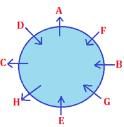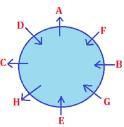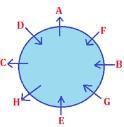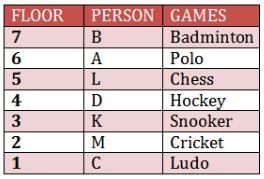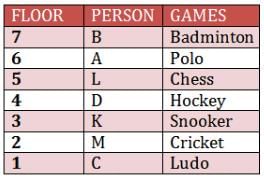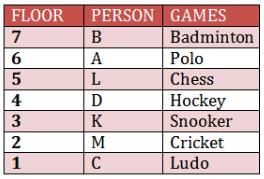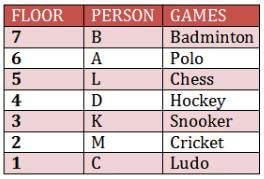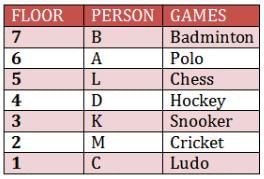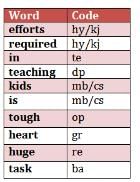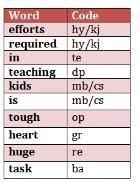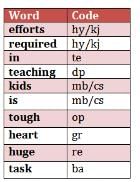NABARD Reasoning Practice : 5 - Banking Exams MCQ
30 Questions MCQ Test - NABARD Reasoning Practice : 5
Study the information carefully and answer the given question.
A B, C, D, E F, G and H are sitting around a circular area of equal distances between each other, but not necessarily in the same order. Some of the people are facing the centre while some face outside. (i.e., in a direction opposite to the centre).
( Note : Same direction means if one person is facing the centre then the other also faces the centre and vice-versa. Opposite direction means that if one person is facing the centre then the other faces outside and vice-versa.)
D sits third to the right of B. E sits second to the left of B. Immediate neighbours of B face the same direction (i.e., if one neighbour faces the centre the other neighbour also faces the centre and vice-versa) C sits second to the left of E. E faces the centre. F sits third to the right of C. G sits second to the left of H. H is not an immediate neighbour of B. G faces the same direction as D. Immediate neighbours of E face opposite directions (i.e., if one neighbour faces the centre the other neighbour faces outside and vice-versa). Immediate neighbours of F face opposite directions (i.e., if one neighbour faces the centre the other neighbour face outside and vice-versa).
Q. How many people in the given arrangement face the centre ?
( Note : Same direction means if one person is facing the centre then the other also faces the centre and vice-versa. Opposite direction means that if one person is facing the centre then the other faces outside and vice-versa.)
D sits third to the right of B. E sits second to the left of B. Immediate neighbours of B face the same direction (i.e., if one neighbour faces the centre the other neighbour also faces the centre and vice-versa) C sits second to the left of E. E faces the centre. F sits third to the right of C. G sits second to the left of H. H is not an immediate neighbour of B. G faces the same direction as D. Immediate neighbours of E face opposite directions (i.e., if one neighbour faces the centre the other neighbour faces outside and vice-versa). Immediate neighbours of F face opposite directions (i.e., if one neighbour faces the centre the other neighbour face outside and vice-versa).
Study the information carefully and answer the given question.
A B, C, D, E F, G and H are sitting around a circular area of equal distances between each other, but not necessarily in the same order. Some of the people are facing the centre while some face outside. (i.e., in a direction opposite to the centre).
( Note : Same direction means if one person is facing the centre then the other also faces the centre and vice-versa. Opposite direction means that if one person is facing the centre then the other faces outside and vice-versa.)
D sits third to the right of B. E sits second to the left of B. Immediate neighbours of B face the same direction (i.e., if one neighbour faces the centre the other neighbour also faces the centre and vice-versa) C sits second to the left of E. E faces the centre. F sits third to the right of C. G sits second to the left of H. H is not an immediate neighbour of B. G faces the same direction as D. Immediate neighbours of E face opposite directions (i.e., if one neighbour faces the centre the other neighbour faces outside and vice-versa). Immediate neighbours of F face opposite directions (i.e., if one neighbour faces the centre the other neighbour face outside and vice-versa).
Q. Which of the following is TRUE regarding A as per the given seating arrangement ?
( Note : Same direction means if one person is facing the centre then the other also faces the centre and vice-versa. Opposite direction means that if one person is facing the centre then the other faces outside and vice-versa.)
D sits third to the right of B. E sits second to the left of B. Immediate neighbours of B face the same direction (i.e., if one neighbour faces the centre the other neighbour also faces the centre and vice-versa) C sits second to the left of E. E faces the centre. F sits third to the right of C. G sits second to the left of H. H is not an immediate neighbour of B. G faces the same direction as D. Immediate neighbours of E face opposite directions (i.e., if one neighbour faces the centre the other neighbour faces outside and vice-versa). Immediate neighbours of F face opposite directions (i.e., if one neighbour faces the centre the other neighbour face outside and vice-versa).
| 1 Crore+ students have signed up on EduRev. Have you? Download the App |
Study the information carefully and answer the given question.
A B, C, D, E F, G and H are sitting around a circular area of equal distances between each other, but not necessarily in the same order. Some of the people are facing the centre while some face outside. (i.e., in a direction opposite to the centre).
( Note : Same direction means if one person is facing the centre then the other also faces the centre and vice-versa. Opposite direction means that if one person is facing the centre then the other faces outside and vice-versa.)
D sits third to the right of B. E sits second to the left of B. Immediate neighbours of B face the same direction (i.e., if one neighbour faces the centre the other neighbour also faces the centre and vice-versa) C sits second to the left of E. E faces the centre. F sits third to the right of C. G sits second to the left of H. H is not an immediate neighbour of B. G faces the same direction as D. Immediate neighbours of E face opposite directions (i.e., if one neighbour faces the centre the other neighbour faces outside and vice-versa). Immediate neighbours of F face opposite directions (i.e., if one neighbour faces the centre the other neighbour face outside and vice-versa).
Q. Four of the following five are alike in a certain way based on the given seating arrangement and so form a group. Which is the one that does not belong to that group ?
( Note : Same direction means if one person is facing the centre then the other also faces the centre and vice-versa. Opposite direction means that if one person is facing the centre then the other faces outside and vice-versa.)
D sits third to the right of B. E sits second to the left of B. Immediate neighbours of B face the same direction (i.e., if one neighbour faces the centre the other neighbour also faces the centre and vice-versa) C sits second to the left of E. E faces the centre. F sits third to the right of C. G sits second to the left of H. H is not an immediate neighbour of B. G faces the same direction as D. Immediate neighbours of E face opposite directions (i.e., if one neighbour faces the centre the other neighbour faces outside and vice-versa). Immediate neighbours of F face opposite directions (i.e., if one neighbour faces the centre the other neighbour face outside and vice-versa).
Study the information carefully and answer the given question.
A B, C, D, E F, G and H are sitting around a circular area of equal distances between each other, but not necessarily in the same order. Some of the people are facing the centre while some face outside. (i.e., in a direction opposite to the centre).
( Note : Same direction means if one person is facing the centre then the other also faces the centre and vice-versa. Opposite direction means that if one person is facing the centre then the other faces outside and vice-versa.)
D sits third to the right of B. E sits second to the left of B. Immediate neighbours of B face the same direction (i.e., if one neighbour faces the centre the other neighbour also faces the centre and vice-versa) C sits second to the left of E. E faces the centre. F sits third to the right of C. G sits second to the left of H. H is not an immediate neighbour of B. G faces the same direction as D. Immediate neighbours of E face opposite directions (i.e., if one neighbour faces the centre the other neighbour faces outside and vice-versa). Immediate neighbours of F face opposite directions (i.e., if one neighbour faces the centre the other neighbour face outside and vice-versa).
Q. What is E’s position with respect to H?
Study the information carefully and answer the given question.
A B, C, D, E F, G and H are sitting around a circular area of equal distances between each other, but not necessarily in the same order. Some of the people are facing the centre while some face outside. (i.e., in a direction opposite to the centre).
( Note : Same direction means if one person is facing the centre then the other also faces the centre and vice-versa. Opposite direction means that if one person is facing the centre then the other faces outside and vice-versa.)
D sits third to the right of B. E sits second to the left of B. Immediate neighbours of B face the same direction (i.e., if one neighbour faces the centre the other neighbour also faces the centre and vice-versa) C sits second to the left of E. E faces the centre. F sits third to the right of C. G sits second to the left of H. H is not an immediate neighbour of B. G faces the same direction as D. Immediate neighbours of E face opposite directions (i.e., if one neighbour faces the centre the other neighbour faces outside and vice-versa). Immediate neighbours of F face opposite directions (i.e., if one neighbour faces the centre the other neighbour face outside and vice-versa).
Q. Who sits second to the left of G?
Study the given information carefully to answer the given question.
A, B, C, D, K, L and M live on seven different floors of a building but not necessarily in the same order. The lowermost floor of the building is numbered one, the one above that is numbered two and so on till the topmost floor is numbered seven. Each one of them also likes different games namely—Snooker, Badminton, Chess, Ludo, Cricket, Hockey and Polo (but not necessarily in the same order.)
Only three people live between B and K. B lives on one of the floors above K. K does not live on the lowermost floor. Only one person lives between B and the one who like Chess. The one who likes Polo lives on one of the even numbered floors above the one who like Chess.
Only two people live between M and the one who like Chess. The one who likes Snooker lives immediately above M. A lives immediately above L. A does not like Chess.
The one who likes Ludo lives on one of the odd numbered floors below L. M does not like Ludo. D lives on one of the Floors above C. Only one person lives between the one who likes Cricket and the one who likes Hockey. D does not like Cricket. M does not like Badminton.
Q. Which of the following games does B like ?
Study the given information carefully to answer the given question.
A, B, C, D, K, L and M live on seven different floors of a building but not necessarily in the same order. The lowermost floor of the building is numbered one, the one above that is numbered two and so on till the topmost floor is numbered seven. Each one of them also likes different games namely—Snooker, Badminton, Chess, Ludo, Cricket, Hockey and Polo (but not necessarily in the same order.)
Only three people live between B and K. B lives on one of the floors above K. K does not live on the lowermost floor. Only one person lives between B and the one who like Chess. The one who likes Polo lives on one of the even numbered floors above the one who like Chess.
Only two people live between M and the one who like Chess. The one who likes Snooker lives immediately above M. A lives immediately above L. A does not like Chess.
The one who likes Ludo lives on one of the odd numbered floors below L. M does not like Ludo. D lives on one of the Floors above C. Only one person lives between the one who likes Cricket and the one who likes Hockey. D does not like Cricket. M does not like Badminton.
Q. Who amongst the following lives on the floor numbered 4 ?
Study the given information carefully to answer the given question.
A, B, C, D, K, L and M live on seven different floors of a building but not necessarily in the same order. The lowermost floor of the building is numbered one, the one above that is numbered two and so on till the topmost floor is numbered seven. Each one of them also likes different games namely—Snooker, Badminton, Chess, Ludo, Cricket, Hockey and Polo (but not necessarily in the same order.)
Only three people live between B and K. B lives on one of the floors above K. K does not live on the lowermost floor. Only one person lives between B and the one who like Chess. The one who likes Polo lives on one of the even numbered floors above the one who like Chess.
Only two people live between M and the one who like Chess. The one who likes Snooker lives immediately above M. A lives immediately above L. A does not like Chess.
The one who likes Ludo lives on one of the odd numbered floors below L. M does not like Ludo. D lives on one of the Floors above C. Only one person lives between the one who likes Cricket and the one who likes Hockey. D does not like Cricket. M does not like Badminton.
Q. Which of the following statements is true with respect to the given arrangement ?
Study the given information carefully to answer the given question.
A, B, C, D, K, L and M live on seven different floors of a building but not necessarily in the same order. The lowermost floor of the building is numbered one, the one above that is numbered two and so on till the topmost floor is numbered seven. Each one of them also likes different games namely—Snooker, Badminton, Chess, Ludo, Cricket, Hockey and Polo (but not necessarily in the same order.)
Only three people live between B and K. B lives on one of the floors above K. K does not live on the lowermost floor. Only one person lives between B and the one who like Chess. The one who likes Polo lives on one of the even numbered floors above the one who like Chess.
Only two people live between M and the one who like Chess. The one who likes Snooker lives immediately above M. A lives immediately above L. A does not like Chess.
The one who likes Ludo lives on one of the odd numbered floors below L. M does not like Ludo. D lives on one of the Floors above C. Only one person lives between the one who likes Cricket and the one who likes Hockey. D does not like Cricket. M does not like Badminton.
Q. If all the people are made to sit in alphabetical order from top to bottom, the positions of how many people will remain unchanged ?
Study the given information carefully to answer the given question.
A, B, C, D, K, L and M live on seven different floors of a building but not necessarily in the same order. The lowermost floor of the building is numbered one, the one above that is numbered two and so on till the topmost floor is numbered seven. Each one of them also likes different games namely—Snooker, Badminton, Chess, Ludo, Cricket, Hockey and Polo (but not necessarily in the same order.)
Only three people live between B and K. B lives on one of the floors above K. K does not live on the lowermost floor. Only one person lives between B and the one who like Chess. The one who likes Polo lives on one of the even numbered floors above the one who like Chess.
Only two people live between M and the one who like Chess. The one who likes Snooker lives immediately above M. A lives immediately above L. A does not like Chess.
The one who likes Ludo lives on one of the odd numbered floors below L. M does not like Ludo. D lives on one of the Floors above C. Only one person lives between the one who likes Cricket and the one who likes Hockey. D does not like Cricket. M does not like Badminton.
Q. Which of the following combinations is true with respect to the given arrangement ?
In this question, two/three statements followed by two conclusions numbered I and II have been given. You have to take the given statements to be true even if they seem to be at variance from the commonly facts and then decide which of the given conclusions logically follows from the given statements disregarding commonly known facts.
Statements :
Some wins are trophies.
Some trophies are cups.
No cup is a prize.
Conclusions :
I. Atleast some cups are wins.
II. All prizes being trophies is a possibility.
In this question, two/three statements followed by two conclusions numbered I and II have been given. You have to take the given statements to be true even if they seem to be at variance from the commonly facts and then decide which of the given conclusions logically follows from the given statements disregarding commonly known facts.
Statements :
No layer is a coat.
All coats are deposits.
All deposits are sheets.
Conclusions :
I. All coats are sheets.
II. All deposits can never be layers.
In this question, two/three statements followed by two conclusions numbered I and II have been given. You have to take the given statements to be true even if they seem to be at variance from the commonly facts and then decide which of the given conclusions logically follows from the given statements disregarding commonly known facts.
Statements :
Some flats are apartments.
No apartment is a hall.
Some halls are rooms.
Conclusions :
I. Atleast some rooms are flats.
II. No apartment is a room.
In this question, two/three statements followed by two conclusions numbered I and II have been given. You have to take the given statements to be true even if they seem to be at variance from the commonly facts and then decide which of the given conclusions logically follows from the given statements disregarding commonly known facts.
Statements :
Some wins are trophies.
Some trophies are cups.
No cup is a prize.
Conclusions :
I. No trophy is a prize.
II. No prize is a win.
In this question, two/three statements followed by two conclusions numbered I and II have been given. You have to take the given statements to be true even if they seem to be at variance from the commonly facts and then decide which of the given conclusions logically follows from the given statements disregarding commonly known facts.
Statements :
Some codes are secrets.
All secrets are puzzles.
Conclusions :
I. All secrets being codes is possibility.
II. Atleast some puzzles are codes.
In this question, relationship between different elements is shown in the statements. The statements are followed by conclusions. Study the conclusions based on the given statement and select the appropriate answer.
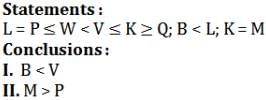
In this question, relationship between different elements is shown in the statements. The statements are followed by conclusions. Study the conclusions based on the given statement and select the appropriate answer.
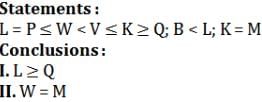
In this question, relationship between different elements is shown in the statements. The statements are followed by conclusions. Study the conclusions based on the given statement and select the appropriate answer.
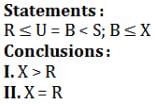
In this question, relationship between different elements is shown in the statements. The statements are followed by conclusions. Study the conclusions based on the given statement and select the appropriate answer.
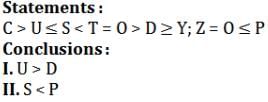
In this question, relationship between different elements is shown in the statements. The statements are followed by conclusions. Study the conclusions based on the given statement and select the appropriate answer.
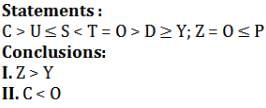
Study the given information carefully to answer the given question.
In a certain code language,
‘ efforts required in teaching’ is written as ‘ dp kj te hy’
‘ teaching kids is tough’ is written as ‘ dp op cs mb’
‘ kids heart is huge’ is written as ‘ cs re mb gr’
‘ task required huge efforts’ is written as ‘ hy kj re ba’
(All codes are two letter codes only.)
Q. In the given code language, what does the code ‘ kj’ stand for ?
Study the given information carefully to answer the given question.
In a certain code language,
‘ efforts required in teaching’ is written as ‘ dp kj te hy’
‘ teaching kids is tough’ is written as ‘ dp op cs mb’
‘ kids heart is huge’ is written as ‘ cs re mb gr’
‘ task required huge efforts’ is written as ‘ hy kj re ba’
(All codes are two letter codes only.)
Q. What is the code for ‘ teaching’ in the given code language?
Study the given information carefully to answer the given question.
In a certain code language,
‘ efforts required in teaching’ is written as ‘ dp kj te hy’
‘ teaching kids is tough’ is written as ‘ dp op cs mb’
‘ kids heart is huge’ is written as ‘ cs re mb gr’
‘ task required huge efforts’ is written as ‘ hy kj re ba’
(All codes are two letter codes only.)
Q. What is the code for ‘ kids’ in the given code language?
Study the given information carefully to answer the given question.
In a certain code language,
‘ efforts required in teaching’ is written as ‘ dp kj te hy’
‘ teaching kids is tough’ is written as ‘ dp op cs mb’
‘ kids heart is huge’ is written as ‘ cs re mb gr’
‘ task required huge efforts’ is written as ‘ hy kj re ba’
(All codes are two letter codes only.)
Q. What will be the code for ‘ in task’ in the given code language?
Study the given information carefully to answer the given question.
In a certain code language,
‘ efforts required in teaching’ is written as ‘ dp kj te hy’
‘ teaching kids is tough’ is written as ‘ dp op cs mb’
‘ kids heart is huge’ is written as ‘ cs re mb gr’
‘ task required huge efforts’ is written as ‘ hy kj re ba’
(All codes are two letter codes only.)
Q. What may be the possible code for ‘ quite tough heart’ in the given code language?
Study the following information to answer the given question.
Ten persons are sitting in two parallel rows containing five persons each. In row 1, Satya, Sanjay , Akshay, Shanti and Sagar are sitting and all of them are facing south. In row 2, Sagarika, Shradha, Sweety, Gaurav and Sonali are sitting and all of them are facing north. In the given seating arrangement, each member seated in a row faces another member of the other row. Moreover, each of them belongs to different cities — Berhampur, Gopalpur, Puri, Balugaon, Balasore, Cuttack, Bhuvaneswar, Sambalpur, Bhadrak and Ikshapur but not necessarily in the same order.
There are only two persons sitting between the person from Berhampur, who sits at an extreme end and Sagar. Sagarika, who sits in the middle of the row, is not an immediate neighbour of Shradha, who is not from Ikshapur. Sonali is sitting at an extreme end. Sagar, from Balasore , sits on the immediate right of the person from Gopalpur and faces the immediate neighhour of Shradha. Sanjay is not sitting at the extreme left end. Sagarika is not from Bhadrak. There is only one person between Akshay and Shanti, who is from Berhamur. Gaurav, from Cuttack, is an immediate neighbour of the person from Ikshapur and does not face the person from Puri. Sweety, who is from Balugaon, is an immediate neighbour of the person from Bhadrak, who in turn faces the immediate neighbour of the person from Balasore. There are two persons between the person from Bhuvaneswar and the person from Puri. Sanjay is not from Bhuvaneswar. Sonali is not from Sambalpur.
Q. Satya belongs to which of the following cities?
Study the following information to answer the given question.
Ten persons are sitting in two parallel rows containing five persons each. In row 1, Satya, Sanjay , Akshay, Shanti and Sagar are sitting and all of them are facing south. In row 2, Sagarika, Shradha, Sweety, Gaurav and Sonali are sitting and all of them are facing north. In the given seating arrangement, each member seated in a row faces another member of the other row. Moreover, each of them belongs to different cities — Berhampur, Gopalpur, Puri, Balugaon, Balasore, Cuttack, Bhuvaneswar, Sambalpur, Bhadrak and Ikshapur but not necessarily in the same order.
There are only two persons sitting between the person from Berhampur, who sits at an extreme end and Sagar. Sagarika, who sits in the middle of the row, is not an immediate neighbour of Shradha, who is not from Ikshapur. Sonali is sitting at an extreme end. Sagar, from Balasore , sits on the immediate right of the person from Gopalpur and faces the immediate neighhour of Shradha. Sanjay is not sitting at the extreme left end. Sagarika is not from Bhadrak. There is only one person between Akshay and Shanti, who is from Berhamur. Gaurav, from Cuttack, is an immediate neighbour of the person from Ikshapur and does not face the person from Puri. Sweety, who is from Balugaon, is an immediate neighbour of the person from Bhadrak, who in turn faces the immediate neighbour of the person from Balasore. There are two persons between the person from Bhuvaneswar and the person from Puri. Sanjay is not from Bhuvaneswar. Sonali is not from Sambalpur.
Q. Who is from Sambalpur?
Study the following information to answer the given question.
Ten persons are sitting in two parallel rows containing five persons each. In row 1, Satya, Sanjay , Akshay, Shanti and Sagar are sitting and all of them are facing south. In row 2, Sagarika, Shradha, Sweety, Gaurav and Sonali are sitting and all of them are facing north. In the given seating arrangement, each member seated in a row faces another member of the other row. Moreover, each of them belongs to different cities — Berhampur, Gopalpur, Puri, Balugaon, Balasore, Cuttack, Bhuvaneswar, Sambalpur, Bhadrak and Ikshapur but not necessarily in the same order.
There are only two persons sitting between the person from Berhampur, who sits at an extreme end and Sagar. Sagarika, who sits in the middle of the row, is not an immediate neighbour of Shradha, who is not from Ikshapur. Sonali is sitting at an extreme end. Sagar, from Balasore , sits on the immediate right of the person from Gopalpur and faces the immediate neighhour of Shradha. Sanjay is not sitting at the extreme left end. Sagarika is not from Bhadrak. There is only one person between Akshay and Shanti, who is from Berhamur. Gaurav, from Cuttack, is an immediate neighbour of the person from Ikshapur and does not face the person from Puri. Sweety, who is from Balugaon, is an immediate neighbour of the person from Bhadrak, who in turn faces the immediate neighbour of the person from Balasore. There are two persons between the person from Bhuvaneswar and the person from Puri. Sanjay is not from Bhuvaneswar. Sonali is not from Sambalpur.
Q. ‘Berhampur’ is related to 'Bhuvaneswar' in a certain way, based on their seating positions. Then Ikshapur is related to whom, following the same seating positions?
Study the following information to answer the given question.
Ten persons are sitting in two parallel rows containing five persons each. In row 1, Satya, Sanjay , Akshay, Shanti and Sagar are sitting and all of them are facing south. In row 2, Sagarika, Shradha, Sweety, Gaurav and Sonali are sitting and all of them are facing north. In the given seating arrangement, each member seated in a row faces another member of the other row. Moreover, each of them belongs to different cities — Berhampur, Gopalpur, Puri, Balugaon, Balasore, Cuttack, Bhuvaneswar, Sambalpur, Bhadrak and Ikshapur but not necessarily in the same order.
There are only two persons sitting between the person from Berhampur, who sits at an extreme end and Sagar. Sagarika, who sits in the middle of the row, is not an immediate neighbour of Shradha, who is not from Ikshapur. Sonali is sitting at an extreme end. Sagar, from Balasore , sits on the immediate right of the person from Gopalpur and faces the immediate neighhour of Shradha. Sanjay is not sitting at the extreme left end. Sagarika is not from Bhadrak. There is only one person between Akshay and Shanti, who is from Berhamur. Gaurav, from Cuttack, is an immediate neighbour of the person from Ikshapur and does not face the person from Puri. Sweety, who is from Balugaon, is an immediate neighbour of the person from Bhadrak, who in turn faces the immediate neighbour of the person from Balasore. There are two persons between the person from Bhuvaneswar and the person from Puri. Sanjay is not from Bhuvaneswar. Sonali is not from Sambalpur.
Q. Four of the following five are alike in a certain way based on their seating positions and so form a group. Which of the following is different from the group?
Study the following information to answer the given question.
Ten persons are sitting in two parallel rows containing five persons each. In row 1, Satya, Sanjay , Akshay, Shanti and Sagar are sitting and all of them are facing south. In row 2, Sagarika, Shradha, Sweety, Gaurav and Sonali are sitting and all of them are facing north. In the given seating arrangement, each member seated in a row faces another member of the other row. Moreover, each of them belongs to different cities — Berhampur, Gopalpur, Puri, Balugaon, Balasore, Cuttack, Bhuvaneswar, Sambalpur, Bhadrak and Ikshapur but not necessarily in the same order.
There are only two persons sitting between the person from Berhampur, who sits at an extreme end and Sagar. Sagarika, who sits in the middle of the row, is not an immediate neighbour of Shradha, who is not from Ikshapur. Sonali is sitting at an extreme end. Sagar, from Balasore , sits on the immediate right of the person from Gopalpur and faces the immediate neighhour of Shradha. Sanjay is not sitting at the extreme left end. Sagarika is not from Bhadrak. There is only one person between Akshay and Shanti, who is from Berhamur. Gaurav, from Cuttack, is an immediate neighbour of the person from Ikshapur and does not face the person from Puri. Sweety, who is from Balugaon, is an immediate neighbour of the person from Bhadrak, who in turn faces the immediate neighbour of the person from Balasore. There are two persons between the person from Bhuvaneswar and the person from Puri. Sanjay is not from Bhuvaneswar. Sonali is not from Sambalpur.
Q. Which of the following statements is/are definitely false?


